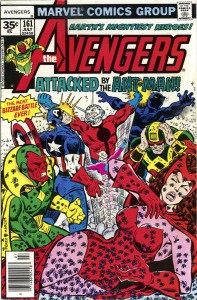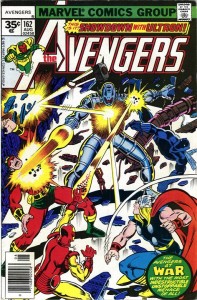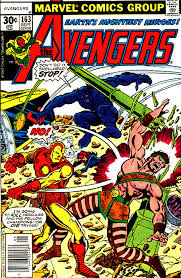Continuing my review (Part One was last week) of the first six Avengers issues written by comics legend Jim Shooter… For those who just want to dive in without reading part one, know that I like Jim Shooter. He did phenomenal work on the Legion of Super-Heroes as a very young teen, and he did a nice job with these issues. But, later, he wrote some phenomenally bad Avengers issues. I’ve often wondered why his second visit to the Mansion was so unsuccessful. So I revisited some of those early, favorite stories of mine to see if I could see the seeds of the bad in what I thought was the good.
 Issue 161: “Beware the Ant-Man!”
Issue 161: “Beware the Ant-Man!”
As a kid, this story was a favorite of mine for several reasons. It had George Perez pencils, the Wasp wore a skimpy costume, it showed Hank Pym as the Ant-Man again, the Wasp wore a skimpy purple costume, the Vision and the Scarlet Witch were a happy couple again, the Wasp word skimpy purple costume that looked like something Dave Cockrum would have designed for the Legion of Super Heroes, Ultron, the coolest villain ever, returned, the Wasp lost her skimpy purple costume around page 25…
Do you get that I was a teenager by the time this issue came out? I’d always thought that Janet Van Dyne Pym, even drawn by the incomparable Perez, was a bit matronly looking. She was, after all, an old married lady. She’d gotten married before I was in kindergarten. But when George Perez decided to draw her in a costume she’d specifically designed to get her husband’s “attention,” I realized that she was supposed to be a very attractive young lady. (Yes, I had a crush on a two-dimensional drawing. I was a very young teenager!)
Short synopsis: Wonder Man is trying on a new costume, designed by the Beast, because his last costume was destroyed fighting with Big Brother Eric last issue. Ant-Man, AKA Yellowjacket AKA Hank Pym, a member of the team who has been largely absent since Shooter began writing the book, shows up and wonders who these strangers are in his team’s headquarters. He attacks, fights them almost to a standstill, and then his wife / partner the Wasp shows up and takes him down. Shortly, Ultron, Hank’s crazy robot “son,” arrives and beats the crap out of the entire team. The Scarlet Witch almost defeats Ultron, but Captain America foolishly steps into her line of fire, and the battle is lost. Along the way, we learn that Ultron wiped Hank’s memory of Ultron’s creation and everything that happened since. Why? So Hank will help him put the Wasp’s “soul” into the robot body Ultron has built to be his robot bride.
This is probably the greatest disappointment, as a re-read, of the whole pack. Loved it when I was a kid, realize, as an adult, that it’s not only a retread plot, it models some ugly story and character tropes, and lays the groundwork for the single worst Avengers story Shooter (or anyone) ever wrote. (But that was in Avengers #213, years later. I won’t talk about it here.)
This story is bad flawed, for all its gorgeous artwork and sexy-as-hell heroine.
First problem – why is Hank an asshole just because he’s lost a few years’ worth of memories? Yeah, he’s probably confused, but why does he start hurling insults and actively trying to kill the Avengers he doesn’t know? Iron Man, who he thinks of as his “new teammate,” is there with them. Wouldn’t a sane man just assume that these are potential recruits, and, I dunno, ask their names before trying to decapitate them? Ah, but you see, Shooter doesn’t think Hank is sane. He just doesn’t come out and say that for a few years. Without saying it, though, it looks like the writer is saying that it’s perfectly reasonable, when your friend brings strangers into someone else’s house, to summarily try to execute them. Seriously, since all Ultron did was erase some memories, there is no excuse for Hank’s behavior in this issue. It’s unbelievable. And it’s a throwback to Shooter’s Legion days, when all the characters could be suddenly and inexplicably hostile to each other for no reason other than to add conflict to the story. Shooter, throughout his career, has had a problem with this element cropping up in his plots.
Second problem – just like the Graviton story, the villain shows up and trashes the whole team with ease. In fact, it happens twice. In the first attack, Ant-Man, probably the weakest member the team ever had, takes out Iron Man, Captain America, the Scarlet Witch, the Beast, the Vision and Wonder Man. Okay, sure, maybe they’re not trying hard, because they don’t want to hurt him, but… seriously? They have to wait for his wife to come save them?
And what… THE HELL… is up with Wanda being freaked out by Hank’s attacking ants when all the others are fine? She’s the most in touch with nature! She’s arguably the most powerful person in the room! But she turns into a puddle of goo and begs for hubby to come get the nasty widdle bugs off her while the big, strong men stand there, probably muttering, “Bugs, eh? They’re a bitch, right?”
And the battle with Ultron? Okay, he’s a bad dude. He’s not a piker. He’s got this encephalo-ray, which, well, we don’t know what it does, but it has a cool name which suggests that your brain is gonna get screwed with if it hits you. And while it figures that android Avenger Vision might have some immunity to a weapon like that, it also figures that the robot who built the android (that would be Ultron) would also know how to mess with his brain. So the Ultron battle is more believable than the Graviton battle was.
But…
Making up for her bout of romance-comic-girlishness, Wanda almost defeats Ultron single-handedly, until Cap, their most seasoned warrior, screws up her chance. I guess that’s an ironic nod to how the Avengers assumed Wanda was a lightweight, but… That’s unbelievable too. The world’s greatest strategist just… steps in the way?
The issue is notable, however, for being the first clear sign of the growing bromance between the Beast and Wonder Man. Yes, the Beast carried Wondy’s body around when he was one of these here zu-vem-bies, and yes, the Beast went and found Wondy when his spirit suddenly returned to his body and he stumbled off into an alley. But those are thing any teammate does. Making you a pretty green-red-and-gold spandex costume? Dude, that’s bromance.
 Issue 162: “The Bride of Ultron!”
Issue 162: “The Bride of Ultron!”
We open the issue with a bunch of dead Avengers. Captain America, the Beast and the Scarlet Witch are being wheeled into ambulances, and the Vision is… not well… and Thor arrives. Iron Man, Wonder Man and the Black Panther, who survived Ultron’s attack, are plotting revenge.
So, just like the Graviton story, Thor has to swoop in and save the day. It’s clear Shooter prefers Thor and T’Challa to the established lineup. And he keeps finding ways to take the “lesser” characters out of action. In this case, four of the team, including three b-listers, are in the morgue, Hank is a barely coherent basket case, and Jan is unconscious. Naked, but unconscious.
Keeping on finding excuses to give the lion’s share of the story to a powerhouse character or characters whom you don’t otherwise develop strikes me as weak storytelling. As a kid, the story definitely held my interest, so it gets points, but… If I were an editor, I would be rejecting it at the outline phase. You have a handful of characters you can “grow” in this book, and a handful you can’t. Of the former group, only one gets any screen time, and that’s pretty limited.
I’m referring to the beginnings of Wonder Man’s fear of death, a good device Shooter would recycle — badly — with Tigra in his second run. But here, it’s interesting to see a man who’s been dead realize that… he didn’t like it. He doesn’t want to go there… wherever there is… again. It was the beginning of a pretty good character arc.
I also have a huge nitpick with this issue, which reveals Shooter’s lack of knowledge of the team’s history: the Panther recalls “if I remember my Avengers history correctly…” and goes on to recall details of Ultron’s past that he, the Panther, was there for. Not a big deal, but it stood out.
Overall an unremarkable story, really. The Avengers defeat Ultron by reversing the transfer of Wasp’s consciousness to the robot bride, they find out that their teammates are only “mostly” dead, and the hint is dropped that it was, after all, the Bride (later to be named Jocasta) who made it all possible. Some neat bits, but not a great issue, no matter how fondly I remembered it.
 Issue 163: “The Demi-God Must Die!”
Issue 163: “The Demi-God Must Die!”
Ugh. So, Shooter began his run with what felt like a fill-in issue, and he ends his run the same way. Like “When Avengers Clash!”, this story just didn’t feel like it fit into the running continuity, even though it directly touched on running continuity.
Why is that?
Well, I don’t think I defined the term “fill-in issue” last week. That’s a bad oversight, I guess, as the modern generation of comic book readers has probably never been exposed to “fill-in issues.” Today, if an artist or author is late turning in material, that issue of the comic is just… late. Sometimes, particularly with big-name creators like Neal Adams or Neil Gaiman… of maybe just with people whose names sound like “Kneel”… a book doesn’t even attempt to come out every 30 days. Sometimes readers are just left hanging, wondering why they haven’t seen the latest issue of a title in three months.
Not so (much) in the old days, when, by God, there was going to be an issue of that title coming out on the listed ship date, no matter what the content between the pages was. I believe it had to do with the Postal regulations which applied to comic books, which were then more often than not mailed to subscribers–there were no comic book stores, once upon a time. The publisher was obligated to release the books on a regular schedule in order to keep their special rate for sending it via USPS. And so, when the regular creative team missed a deadline, a fill-in issue was published. This was a story by another team. Sometimes it was just a reprint from days gone by. Sometimes, forward-thinking editors bought “inventory” stories and kept them ready to publish against the day when a deadline was missed.
Indeed, sometimes fill-ins were planned so that the regular team could take a vacation. I was Howie Weinstein’s go-to fill-in writer while he had the Classic Star Trek assignment at DC Comics. Howie, bless him, took an annual vacation and I got to work. (That did not, as he hoped, mean I got the book full-time when he quit. That assignment went to a book editor from another company, because the comic editor at the time was looking for a new job. She got the new job.)
Fill-ins worked okay for books like Star Trek, in which the readers expected the stories to end neatly and not tie to the next issue. They didn’t work well for something like Avengers in the 1970s, because the readers expected continuing story arcs, as modern TV viewers do. So why did a story by the regular writer, albeit drawn by a fill-in artist (the wonderful George Tuska) feel like a fill-in?
Well, to begin with, because so many of the regular cast were absent. It seems the hallmark of Shooter’s first run on this book was that he liked to split up the team, sending more than half the regulars off into limbo for a while while he focused on the rest. This worked well in his Legion days. It was common to only have a handful of Legionnaires in any one story. But there were two dozen Legionnaires, even when Shooter was writing them. There weren’t only seven regular cast members and one or two recurring guests, as with the Avengers.
So Iron Man and the Beast are at the Mansion alone. Here we have the requisite “power” member, which Shooter seems to require, and we have the comic relief. Typhon, an old enemy of former Avenger Hercules, shows up, demanding to battle his old foe. He holds the Beast hostage against Iron Man’s good behavior, sending the armored Avenger out to corral Hercules. Hercules is in LA, a member of the Champions. So he responds to an emergency call with his teammates: the Black Widow, another former Avenger, and Iceman.
Battle ensues. Yay.
I’ve always disliked Typhon. And, indeed, this story so parallels his first appearance, it’s not surprising. He first showed up in Avengers #50, right in the middle of a very gripping storyline about Magneto, Quicksilver and the Scarlet Witch. That story just kind of… stopped… so that Hercules could battle Typhon for an issue. That felt like a fill-in, too. And it was similarly boring to me. I didn’t read Avengers so I could be treated to a back-door pilot for one character. And I didn’t like it when most of the regulars were crowded out of the issue for an “action story.” It’s like going to the theatre to see Inherit the Wind and finding out they’re staging a championship boxing match instead.
So, even though the Champions were favorites of mine, and the issue was drawn by one of their regular artists, this story just didn’t work for me. It featured too little of the membership of either group, and focused way too heavily on the strongest member of each. So little time was spent on character development that the Iceman and the Beast, school chums who used to double date in Greenwich Village coffee houses, barely even say “hello” to each other. Nor does the Black Widow even think to ask Iron Man if he’s heard from Hawkeye, the man she almost married.
So… there it all is. With the next issue would begin “The Korvac Saga,” which is much-talked about, but not necessarily well-liked. But Shooter’s pattern was established, I think. He didn’t like a regular lineup, he didn’t let the established history of a character get in the way of telling a dramatic story, he clearly thought Hank Pym was an asshole by nature, and, although he featured him prominently in two issues, he didn’t have much use for the Vision. The Vision had long been the iconic Avenger, but it was Shooter who later wrote him out of the series, along with the Scarlet Witch.
It’s funny what you don’t notice as a kid. Sometimes the best part of childhood is that you don’t know what’s coming. And sometimes one of the cool parts of adulthood is that you have a chance to make sense of what did come.
